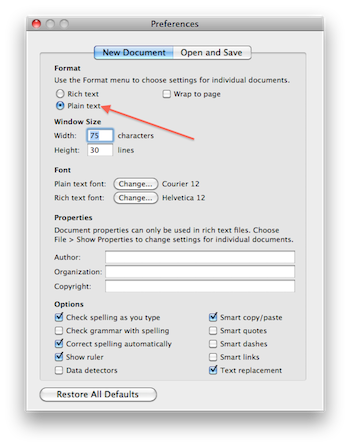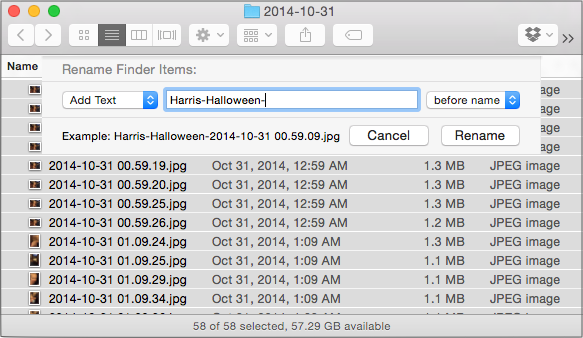Batch File Renamer Os X
WindowsRELATED:We’ve already covered the many ways to batch-rename files on Windows. For basic batch-renaming, begin by selecting several files in Windows Explorer or File Explorer. Press Ctrl+A to select a folder full of files, use the mouse cursor to select a group, or hold Ctrl as you click to select and de-select files.RELATED:When you’re ready, right-click a file in the list and select Rename — or just press F2.
Type a new “base name” for the files, such as My Vacation, and press Enter. The files will be renamed as My Vacation (1), My Vacation (2), and so on. This will give all those files a much more logical name, grouping them together.More advanced operations will need. (Be extremely careful when downloading and running such third-party software, as.)Mac OS XMac OS X’s Finder gained its own batch-rename function in version. These built-in batch renaming features are much more powerful than the built-in Windows ones.To get started, select the files you want to rename in the Finder, Ctrl-click or right-click them, and select Rename items. You’ll see a Rename dialog where you can choose between three options. Here’s what they do:.

Replace Text: This option lets you perform a search and replace in the selected files’ names. Enter text you want to find and the text you want to replace it with. For example, you could replace the words “My Vacation” with “Paris Trip.” Or you could search for a bit of text and replace it with nothing at all, snipping that bit of text out of every file name. Add Text: This option allows you to add some text to each file name. You can add the text either before or after the name. Format: This is the most complicated option.

Batch File Renamer. Out of the box in OS X. If you want to batch rename files. 3 Easy Ways to Batch Rename Files on the Mac. Batch file renaming doesn’t come easy to the. Download A Better Finder Rename 10.07. For Mac OS X. A Better Finder Rename has long been the file renamer of. A Better Finder Rename takes file. For Mac OS X 10.7 and later. Better Rename has long been the file renamer of choice for tens of thousands of. Make up your own mind and download the free trial.
You can “format” file names, using a base name and a number. This works similar to the equivalent renaming feature on Windows. You could also use the file’s associated date instead of a number. The number or date can appear before or after the base name.This may sound a bit complicated, but it’s not too bad. You’ll see a preview of the resulting file name appear below the Rename dialog, so you can see exactly how the files will be named.
Feel free to experiment!LinuxRELATED:Some come with an integrated batch-renaming tool, and some don’t. The used by and GNOME doesn’t have this feature built-in.If you’re using a KDE desktop, the standard Dolphin file manager does have this integrated. It works like the batch rename feature on Windows.
Select multiple files, right-click them, and select Rename or press F2. Enter a base name for the files, including the # symbol somewhere in it. The # symbol will be replaced by a sequential number for each file name. For example, if you enter Photo # From My Vacation.jpg, you’ll get files named “Photo 1 From My Vacation.jpg,” “Photo 2 From My Vacation.jpg,” and so on.The Xfce desktop and its Thunar file manager has an easy-to-use, powerful bulk rename tool built into it. To access it, select some files in Thunar, right-click them, and click Rename. This tool can do everything from renaming files based on their audio tags, inserting a date and time, numbering files, performing a search and replace, making text uppercase or lowercase, inserting or deleting characters at a specific position in the file name, and so on.Thunar’s interface is powerful, but it’s also fairly simple to understand.
The preview of how each file’s name will look afterwards helps you experiment safely, so you can see exactly what its functions will do.On other desktop environments, you can head to your Linux distribution’s software management program and install a bulk-rename tool. We do like Thunar’s Bulk Rename tool, even on GNOME and Unity desktops. Install Thunar on another desktop environment to get a “Bulk Rename” tool you can launch directly from your Linux desktop’s applications menu. Drag-and-drop files from your desktop’s file manager into the Bulk Rename window to start renaming them.You can even.As on other operaitng systems, you can also batch-rename files from the terminal. The Linux terminal is so powerful that you can.Batch-renaming isn’t something every computer user needs to do regularly, but it is often useful. That batch of oddly named image files from your digital camera’s are prime targets for a good batch-renaming when you import them to your computer.Image Credit.
In early versions of Mac OS, users looking for a way to quickly rename multiple files simultaneously (commonly referred to as batch renaming) had to use the command line or download and install a third-party tool dedicated to the task.Since OS X Yosemite however, Apple has integrated several useful batch renaming capabilities directly into Finder.To rename several files of the same kind on your Mac at once, follow the steps below. In our example we're going to be batch renaming some photos. Open a Finder window and locate the files you want to rename. Drag a selection box over the files with your mouse or hold the Shift key and click them one by one.
Click the Action button in the Finder toolbar. Alternatively, right-click (or Ctrl-click) one of the selected files in the Finder window. Select Rename XX Items in the menu. Select Format from the first dropdown menu in the Rename Finder Items panel. In the next dropdown, select a Name format. We're going to use Name and Index, but you can optionally select Name and Counter or Name and Date. Enter a common name for your files in the Custom Format field.
Enter a starting number for the file series in the Start numbers at field. Note that if you selected a number format, you can use the Where dropdown to choose whether the sequential numbers appear before or after the common name of your files. Make sure you're happy with the preview example at the bottom of the Rename panel, then click Rename.
Batch File Renamer Free
The selected files will now be renamed with your chosen nomenclature. Note that if you're note happy with the change, you can select Edit - Undo Rename in the Finder menu bar or press the keys Command-Z to revert the files back to their original names.
How to Add Text to Existing File NamesFinder's renaming tool also lets you add supplementary text to filenames without changing their original titles.Simply select the files whose names you want to adjust and bring up the Rename Finder Items panel as described above, only select Add Text from the from the first dropdown instead. Then just type in the additional text in the input field. How to Search and Replace Text in File NamesFinder also allows you to rename only certain files whose names include a certain piece of identifying text. This is particularly convenient if you have tens or hundreds of files in a folder with different names and you only want to change those files that contain a particular word.Select all the files in a folder (make sure they're all of the same kind, or this won't work), bring up the Rename Finder Items panel in the same way as before, but this time select Replace Text in the first dropdown.Now simply type the identifying text you want to replace into the Find field, and enter the text you want to replace it with in the Replace With field, then click Rename. In early versions of Mac OS, users looking for a way to quickly rename multiple files simultaneously (commonly referred to as batch renaming) had to use the command line or download and install a third-party tool dedicated to the task.Automator!?!?!?It’s like Apple built in a few Automator scripts into Finder, because I had 2 scripts saved from back in 2006 for exactly this purpose: batch renaming files, and replacing words in filenames with other words.

I’m not a programmer or anything, but Apple made Automator so easy to use!!I used my Automator for naming imported photos using a specific format I liked (YYYY-MM-DD, photo number starting from 001, then Custom text/title), as well as renaming songs in music albums a certain way (01. Artist Name - Song Name), etc.This looks good too; better in some ways, but worse in others. LIST=1. Drag a selection box over the files with your mouse or hold the Shift key and click them one by one.Nitpicky here, but I would recommend command-click instead of shift-click. If you select two non-adjacent files with shift-click, it will select all of the files in between.
Advanced Renamer Mac
Great if you want that, but if you don't, go with command-click for selecting items one by one.doublepost=/doublepostThis is actually pretty cool. As a graphic designer who sometimes deals with hundreds of photos and other creative assets per project, this is a great way to efficiently sort and organize files.Same. Photoshop has some built-in file renaming capabilities but (par for the course for Adobe) it's a bit convoluted and harder to set up.For next-level file renaming past what Finder can do, A Better Finder Rename ('has lots of additional features.doublepost=/doublepostI just found it interesting since macOS is usually more intuitive. That Apple implemented a more roundabout solution for this.I think this is more intuitive in that it's called out in the interface and walks you through the options.
Top News
- Plantronics Voyager Pro Drivers Windows
- Shiv Charitra Book In Marathi Pdf
- Heavy Rain Game Download Pc Free
- Caracteristicas Ventajas Desventajas Software Educativo De Historia
- Omnimo 6 Free Download
- Ib Question Bank Ess
- Crack Auto Vo Lam 2 Hack
- Burris Four X 3 12x56 Manual Transmission
- Medea Vasp Download
- Baixar Audio Do Dvd Revelacao 360
- Srs Audio Sandbox 1.7 Crack
- Security Monitor Pro Serial 5
- Tomb Raider Angel Of Darkness Keygen Idm





